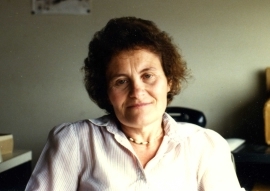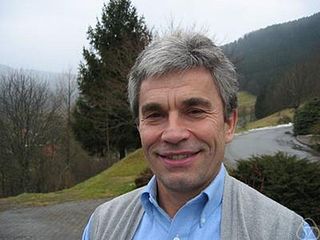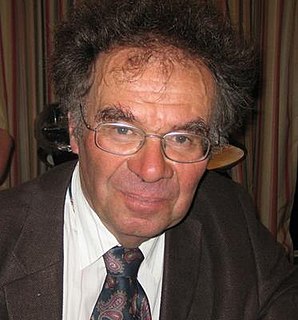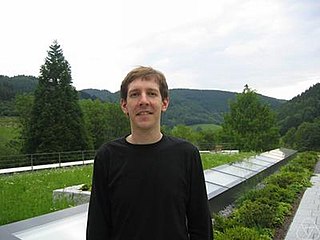
In mathematics, arithmetic geometry is roughly the application of techniques from algebraic geometry to problems in number theory. Arithmetic geometry is centered around Diophantine geometry, the study of rational points of algebraic varieties.
In mathematics, a Barlow surface is one of the complex surfaces introduced by Rebecca Barlow. They are simply connected surfaces of general type with pg = 0. They are homeomorphic but not diffeomorphic to a projective plane blown up in 8 points. The Hodge diamond for the Barlow surfaces is:

Trevor Dion Wooley FRS is a British mathematician and currently Professor of Mathematics at Purdue University. His fields of interest include analytic number theory, Diophantine equations and Diophantine problems, harmonic analysis, the Hardy-Littlewood circle method, and the theory and applications of exponential sums. He has made significant breakthroughs on Waring's problem, for which he was awarded the Salem Prize in 1998.
In mathematics, the local Langlands conjectures, introduced by Robert Langlands, are part of the Langlands program. They describe a correspondence between the complex representations of a reductive algebraic group G over a local field F, and representations of the Langlands group of F into the L-group of G. This correspondence is not a bijection in general. The conjectures can be thought of as a generalization of local class field theory from abelian Galois groups to non-abelian Galois groups.

Alexander A. Beilinson is the David and Mary Winton Green University professor at the University of Chicago and works on mathematics. His research has spanned representation theory, algebraic geometry and mathematical physics. In 1999 Beilinson was awarded the Ostrowski Prize with Helmut Hofer. In 2017 he was elected to the National Academy of Sciences.

Marina Evseevna Ratner was a professor of mathematics at the University of California, Berkeley who worked in ergodic theory. Around 1990, she proved a group of major theorems concerning unipotent flows on homogeneous spaces, known as Ratner's theorems. Ratner was elected to the American Academy of Arts and Sciences in 1992, awarded the Ostrowski Prize in 1993 and elected to the National Academy of Sciences the same year. In 1994, she was awarded the John J. Carty Award from the National Academy of Sciences.
In mathematics, a p-adic zeta function, or more generally a p-adic L-function, is a function analogous to the Riemann zeta function, or more general L-functions, but whose domain and target are p-adic. For example, the domain could be the p-adic integersZp, a profinite p-group, or a p-adic family of Galois representations, and the image could be the p-adic numbersQp or its algebraic closure.

Florian Pop is a Romanian mathematician, a professor of mathematics at the University of Pennsylvania.
In group theory, the trichotomy theorem divides the finite simple groups of characteristic 2 type and rank at least 3 into three classes. It was proved by Aschbacher for rank 3 and by Gorenstein & Lyons (1983) for rank at least 4. The three classes are groups of GF(2) type, groups of "standard type" for some odd prime, and groups of uniqueness type, where Aschbacher proved that there are no simple groups.

Kai Behrend is a German mathematician. He is a professor at the University of British Columbia in Vancouver, British Columbia, Canada.
In mathematics, the Langlands–Deligne local constant, also known as the local epsilon factor or local Artin root number, is an elementary function associated with a representation of the Weil group of a local field. The functional equation
James S. Milne is a New Zealand mathematician working in arithmetic geometry.
In complex analysis, the Siu semicontinuity theorem implies that the Lelong number of a closed positive current on a complex manifold is semicontinuous. More precisely, the points where the Lelong number is at least some constant form a complex subvariety. This was conjectured by Harvey & King (1972) and proved by Siu. Demailly (1987) generalized Siu's theorem to more general versions of the Lelong number.
In mathematics, Artin's criteria are a collection of related necessary and sufficient conditions on deformation functors which prove the representability of these functors as either Algebraic spaces or as Algebraic stacks. In particular, these conditions are used in the construction of the moduli stack of elliptic curves and the construction of the moduli stack of pointed curves.

Günter Harder is a German mathematician, specializing in arithmetic geometry and number theory.
Jacques Tilouine is a professor of mathematics at Université Sorbonne Paris Nord working in number theory and automorphic forms, particularly Iwasawa theory.

Francesco Damien "Frank" Calegari is a professor of mathematics at the University of Chicago working in number theory and the Langlands program.

Bhargav Bhatt is a mathematician who is the Fernholz Joint Professor at the Institute for Advanced Study and Princeton University and works in arithmetic geometry and commutative algebra.

Sebastiaan Johan Edixhoven was a Dutch mathematician who worked in arithmetic geometry. He was a professor at University of Rennes 1 and Leiden University.

Ronen Eldan is an Israeli mathematician. Eldan is a professor at the Weizmann Institute of Science working on probability theory, mathematical analysis, theoretical computer science and the theory of machine learning. He received the 2018 Erdős Prize, the 2022 Blavatnik Award for Young Scientists and was a speaker at the 2022 International Congress of Mathematicians.











